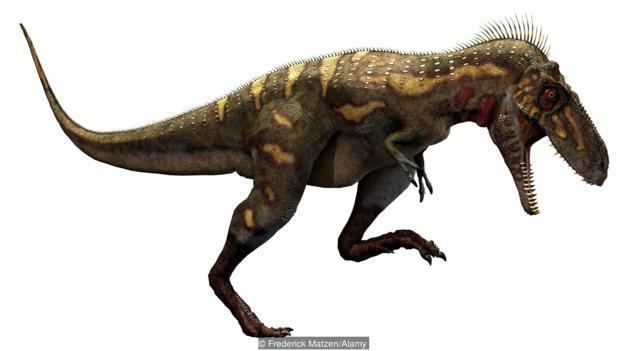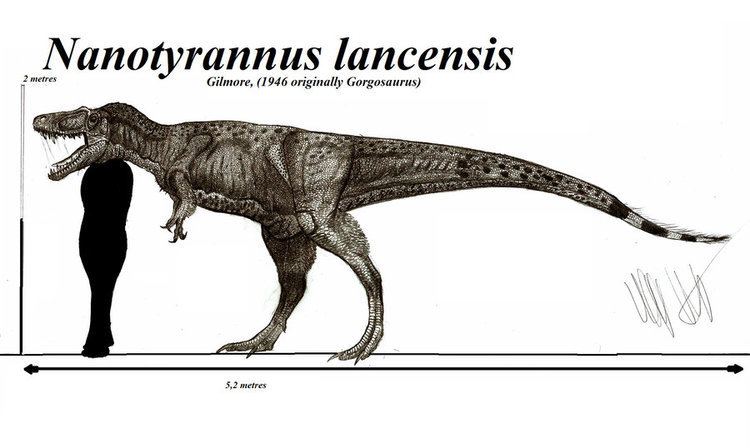Kingdom Animalia Clade Dinosauria Family †Tyrannosauridae Scientific name Nanotyrannus Rank Genus | Class Reptilia Suborder Theropoda Subfamily †Tyrannosaurinae Phylum Chordata Order Saurischia | |
 | ||
Similar Albertosaurus, Gorgosaurus, Tyrannosauridae, Daspletosaurus, Alioramus | ||
Nanotyrannus vs t rex
Nanotyrannus ("dwarf tyrant") is a potentially dubious genus of tyrannosaurid dinosaur. It is known only from two specimens (possibly three), which are potentially juvenile specimens of the contemporary genus Tyrannosaurus rex.
Contents

What is nanotyrannus
HistoryEdit

Nanotyrannus is based on CMNH 7541, a skull collected in 1942 by David Hosbrook Dunkle and described by Charles W. Gilmore in 1946, who classified it as a new species in the tyrannosaur genus Gorgosaurus as G. lancensis. In 1988, the specimen was re-described by Robert T. Bakker, Phil Currie, and Michael Williams, then the curator of paleontology at the Cleveland Museum of Natural History, where the original specimen was housed and is currently on display. Their initial research indicated that the skull bones were fused, and that it therefore represented an adult specimen. In light of this, Bakker and colleagues assigned the skull to a new genus, named Nanotyrannus for its apparently small adult size. The specimen is estimated to have been around 5.2 metres (17 ft) long when it died. However, a detailed analysis of the specimen by Thomas Carr in 1999 showed that the specimen was in fact a juvenile, leading Carr and many other paleontologists to consider it a juvenile specimen of Tyrannosaurus rex.

In 2001, a more complete juvenile tyrannosaur (nicknamed "Jane", catalogue number BMRP 2002.4.1), belonging to the same species as the original Nanotyrannus specimen, was uncovered. This discovery prompted a conference on tyrannosaurs focused on the issues of Nanotyrannus validity, held at the Burpee Museum of Natural History in 2005. Several paleontologists who had previously published opinions that N. lancensis was a valid species, including Currie and Williams, saw the discovery of "Jane" as a confirmation that Nanotyrannus was in fact a juvenile T. rex. On the other hand, some, such as Peter Larson, continued to support the hypothesis that Nanotyrannus lancensis was a separate but closely related species. In 2015, Professor Phil Manning and Dr Charlotte Brassie of Manchester University studied Jane using a LIDAR scanner, and using data and computer modelling, their reconstruction of body mass suggested that Jane had a 600 kg - 900 kg body mass, far lower than would be expected for a Tyrannosaurus. Also in 2015, Assistant Professor Holly Woodward Ballard of Oklahoma State University used histology to examine a thin slice of Jane's femur. Counting the rings within Jane's bone material showed that Jane was 11 years old, and bone histology suggests that Jane was immature and still growing.
The actual scientific study of "Jane" may determine whether Nanotyrannus lancensis is a valid species or if it represents a juvenile T. rex.
In late 2011, news reports about a 2006 discovery of a new, virtually complete tyrannosaurid specimen found along with a ceratopsid were made. The specimens were studied by Robert Bakker and Pete Larson on-site, who identified the ceratopsian as Triceratops and the tyrannosaurid as Nanotyrannus. The specimen, nicknamed "Bloody Mary", allegedly has arms almost 3 feet in length, with the bones of the hand said to be one and a half times longer than those of the T. rex specimen "Sue". However, the truth to those claims, and whether the specimen is distinct from T. rex, are currently impossible to determine, as the "Bloody Mary" specimen remains in private hands and away from scientific access.
ValidityEdit
The primary difference that some scientists have used to argue for Nanotyrannus lancensis's validity concerns the number of teeth. Specimens referred to N. lancensis had 14-15 teeth in each side of the upper jaw (maxilla) and 17 teeth in each side of the lower jaw (dentary), whereas adult T. rex specimens had 11-12 tooth positions in the upper jaw and 11-14 in the lower. The exact implications of this difference in tooth count have not been universally accepted, however. In his 1999 study of tyrannosaurid growth patterns, Carr showed that, in Gorgosaurus libratus, the number of teeth decreased as the animal grew, and he used this data to support the hypothesis that N. lancensis is simply a juvenile T. rex. Tsujihi et al., who studied growth in the related Tarbosaurus bataar, found little to no decrease in tooth count during growth, even though they had juvenile specimens much younger than the Nanotyrannus specimens. These researchers also noted, however, that both Tyrannosaurus and Gorgosaurus show significant differences in tooth count between individuals of the same age group, and that tooth count may vary on an individual basis not related to growth. Larson has also contended that, along with skull features, Nanotyrannus can also be distinguished from Tyrannosaurus by proportionally larger hands with phalanges on the third metacarpal and in the furcula morphology.
Another difference cited by those who support the validity of N. lancensis is the presence of a small foramen, or pit, in the quadratojugal, a bone in the back corner of the skull. Both the holotype and the "Jane" specimen have this feature, suggesting it is not a deformity, and it is not known in any adult tyrannosaurid specimens. It is possible that this is again an individual variant, or that it was a feature lost as the animals grew, though studies of other juvenile tyrannosaurids do not show an equivalent feature. However, most of the differences claimed to support Nanotyrannus turned out to be individually or ontogenetically variable features. The foramen at the quadratojugal is also problematic for the validity of Nanotyrannus, as skull sutures are ambiguous evidence for maturity in archosaurs.
3D models of the brain cavities of the holotype skull and T. rex's skull show that blood vessel positions and those of the optic nerve attachments do not match, possibly suggesting a distinction between Nanotyrannus and T. rex. This could be accounted for by changes in the skull shape as T. rex grows.
Limb proportion analysis published in 2016 suggested that Nanotyrannus specimens have differing levels of cursoriality, cited as a potential difference between N. lancensis and T. rex. However, paleontologist Manabu Sakomoto has commented that this conclusion is likely impacted by low sample size, and the discrepancy does not necessarily reflect taxonomic distinction.
